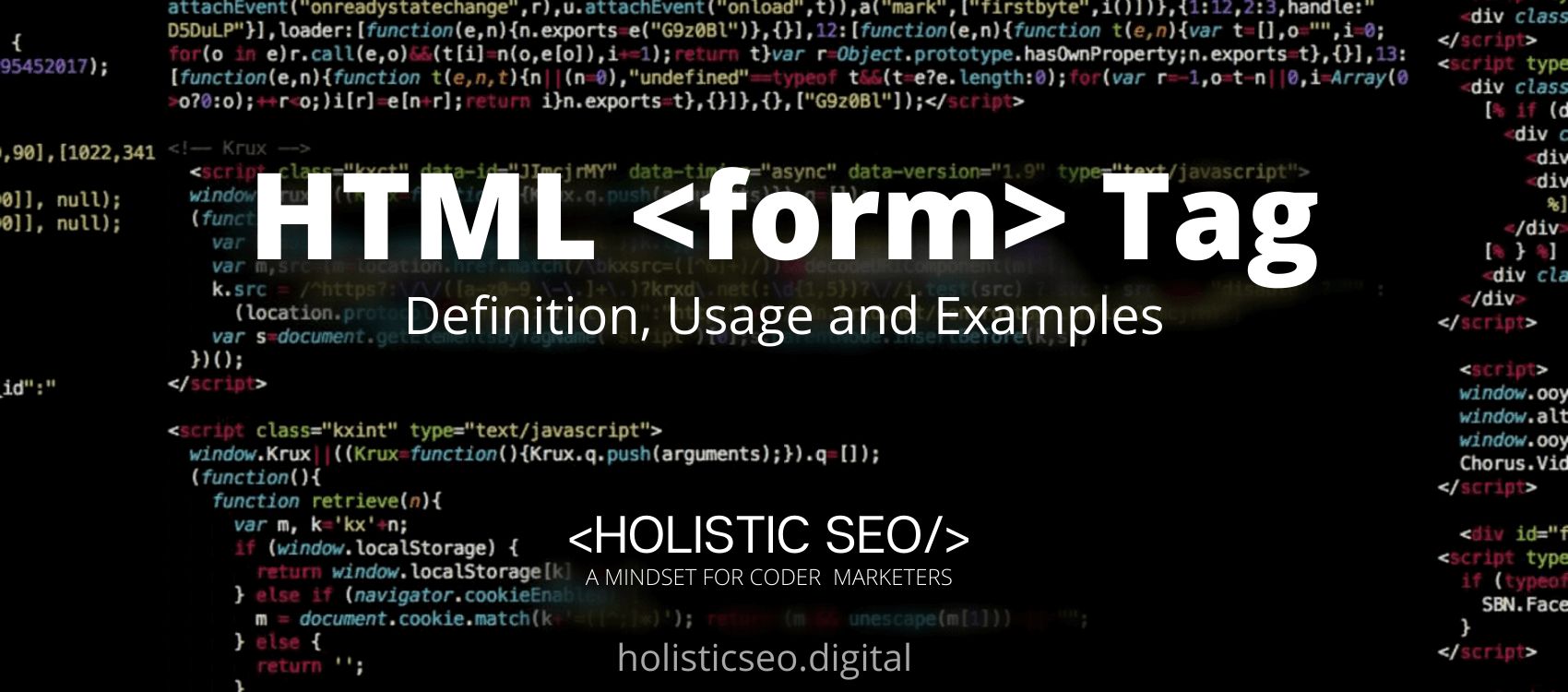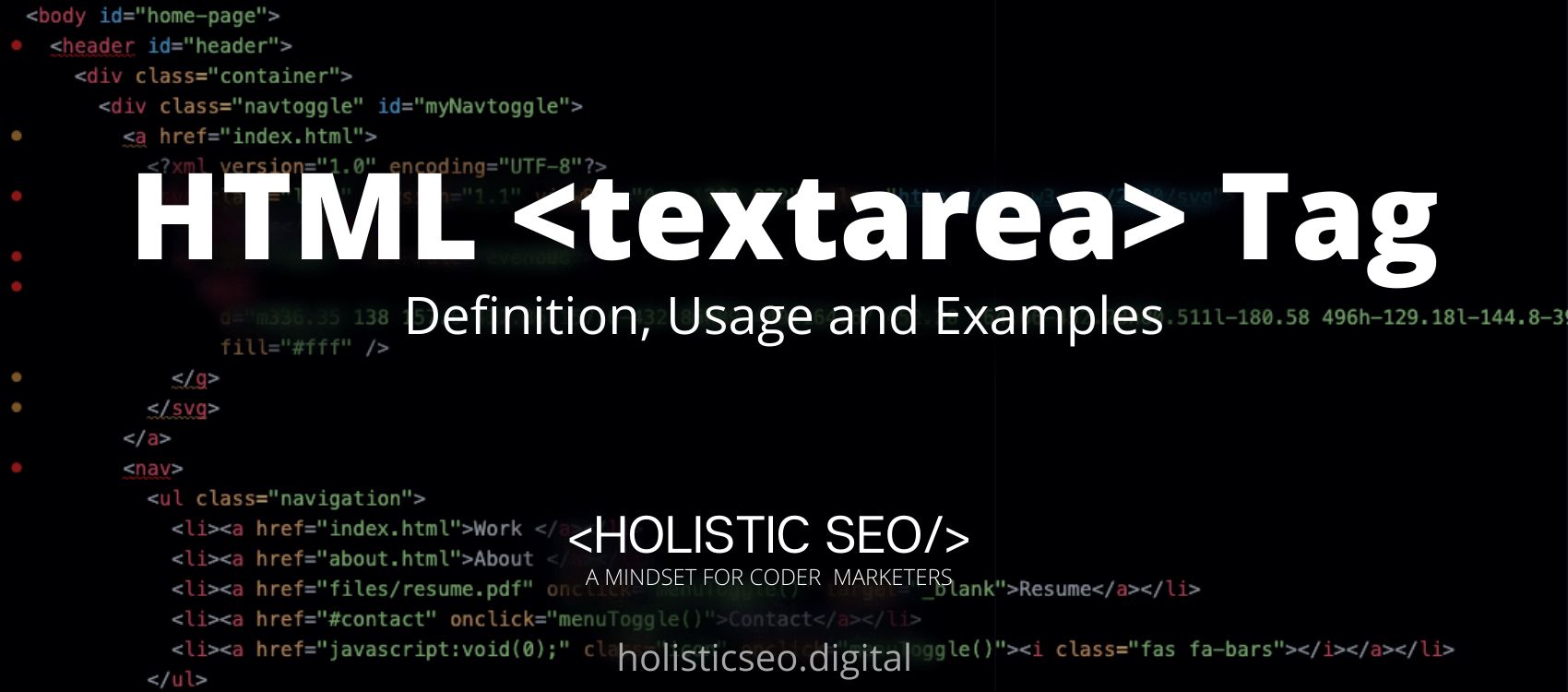The <form> HTML Tag is used to define an HTML form that will accept user input. The <form> HTML Tag contains any of the form elements including <input>, <textarea>, <button>, <select>, <option>, <optgroup>, <fieldset>, <label>, and <output> HTML Tag. The <form> HTML Tag is part of the Forms and Input HTML category in HTML Element Reference. The attributes of the <form> HTML Tag are accept-charset, action, autocomplete, enctype, method, name, novalidate, rel, target, global, and event attributes.
<form> code block example to learn how it works is given below.
<form action="process_form.cfm" method="get">
...Form-associated elements...
</form>The second example usage of the “<form>” code block example is given below.
<form action="" method="get" class="form-example">
<div class="form-example">
<label for="name">Full Name: </label>
<input type="text" name="name" id="name" required>
</div>
<div class="form-example">
<label for="email">Email Address: </label>
<input type="email" name="email" id="email" required>
</div>
<div class="form-example">
<input type="submit" value="Submit!">
</div>
</form>What is <form> HTML Tag?
The <form> HTML Tag is used in connection with elements that are associated with forms. Typically, to create a form, it nests form-related elements within the opening and closing form tags. Additionally, the form attribute can be used within those elements to reference the form’s ID.
How to Use <form> HTML Tag?
To use <form> HTML Tag, the web developer should create a <form></form> HTML Tag that contains any number of form-related elements nestled between the start and end tags. Typically, the <form> HTML Tag includes an action attribute that specifies the page that will process the form. Additionally, it may possess additional characteristics.
Example Usage of <form> HTML Tag?
The following example of usage of <form> HTML Tag is given below.
<form action="" method="get" class="form-example">
<div class="form-example">
<label for="email">Email Address: </label>
<input type="email" name="email" id="email" required>
</div>
<div class="form-example">
<label for="password"> Password: </label>
<input type="password" name="password" id="password" required>
</div>
<div class="form-example">
<input type="submit" value="Get Started!">
</div>
</form>What are the Attributes of <form> HTML Tag?
There are multiple attributes for the <form> HTML Tag. The following attributes are listed below.
- Accept-charset Attribute: The <form> HTML Tag supports accept-charset attribute. The accept-charset attribute specifies the character encodings to be used when submitting the form.
- Action Attribute: The <form> HTML Tag supports action attribute. The action attribute is used to specify where form-data should be sent when a form is submitted.
- Autocomplete Attribute: The <form> HTML Tag supports autocomplete attribute. The autocomplete attribute specifies whether autocomplete should be enabled or disabled for a form.
- Enctype Attribute: The <form> HTML Tag supports enctype attribute. The enctype attribute specifies the encoding method to use when submitting form data to the server.
- Method Attribute: The <form> HTML Tag supports method attribute. The method attribute specifies the HTTP method to use for form-data submission.
- Name Attribute: The <form> HTML Tag supports name attribute. The name attribute specifies a form’s name.
- Novalidate Attribute: The <form> HTML Tag supports novalidate attribute. The novalidate attribute specifies that when the form is submitted, it should not be validated.
- Rel Attribute: The <form> HTML Tag supports rel attribute. The rel attribute establishes a connection between a linked resource and the current document.
- Target Attribute: The <form> HTML Tag supports target attribute. The target attribute specifies the location of the response received after the form is submitted.
- Global Attributes: The <form> HTML Tag supports global attributes. All HTML elements, even those not specified in the standard, can have global attributes. This means that any non-standard elements must nevertheless allow certain characteristics, even if using such elements makes the content non-HTML5 compliant.
- Event Attributes: The <form> HTML Tag supports event attributes. The Event Attributes always have a name that begins with “on” and is followed by the name of the event for which it is intended. They specify a script to run when an event of the defined type is dispatched to the element with the specified attributes.
What are the Default CSS Settings for <form> HTML Tag?
The following are the Default CSS Settings for the <form> HTML Tag.
form.form-example {
display: table;
}
div.form-example {
display: table-row;
}
label, input {
display: table-cell;
margin-bottom: 10px;
}
label {
padding-right: 10px;
}What are the Related other HTML Tags to <form>?
The other related HTML Tags to <form> HTML Tag are listed below.
- <input> HTML Tag: The <input> HTML Tag is related to <form> HTML Tag because they are both forms and input tags. The <input> HTML Tag is used to specify the Input Element.
- <textarea> HTML Tag: The <textarea> HTML Tag is related to <form> HTML Tag because they are both forms and input tags. The HTML Tag <textarea> is used to specify a text input element.
- <button> HTML Tag: The <button> HTML Tag is related to <form> HTML Tag because they are both forms and input tags. The HTML button is created using the <button> HTML Tag.
- <select> HTML Tag: The <select> HTML Tag is related to <form> HTML Tag because they are both forms and input tags. The <select> HTML Tag is used to define a drop down list.
- <optgroup> HTML Tag: The <optgroup> HTML Tag is related to <form> HTML Tag because they are both forms and input tags. The <optgroup> HTML Tag denotes a group of options in a drop-down list.
- 48 Online Shopping and Consumer Behavior Statistics, Facts and Trends - August 22, 2023
- B2B Marketing Statistics - August 22, 2023
- 38 Podcast Statistics, Facts, and Trends - August 22, 2023


